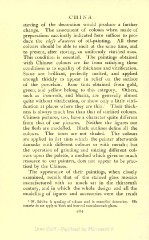Page 494 - Oriental Series Japan and China, Brinkly
P. 494
CHINA
stoving of the decoration would produce a further
change. The assortment of colours when made of
preparations succinctly indicated here suffices to pro-
duce the chefs d? ceuvres of oil-painting. All these
colours should be able to melt at the same time, and
to present, after stoving, an uniformly vitrified mass.
This condition is essential. The paintings obtained
with Chinese colours are far from satisfying these
conditions as to equality of thickness and vitrification.
Some are brilliant, perfectly melted, and applied
enough thickly to appear in relief on the surface
of the porcelain. Rose tints obtained from gold,
green, and yellow belong to this category. Others,
such as iron-reds, and blacks, are generally almost
quite without vitrification, or show only a little vitri-
fication at places where they are 1 Their thick-
thin.
ness is always much less than that of vitrified colours.
Chinese pictures, too, have a character quite different
from that of our pictures. Neither the figures nor
the flesh are modelled. Black outlines define all the
colours. The tones are not shaded. The colours
are applied in flat tints which the painter afterwards
damasks with different colours or with metals but
;
the operation of grinding and mixing different col-
ours upon the palette, a method which gives so much
resource to our painters, does not appear to be prac-
tised by the Chinese.
The appearance of their paintings, when closely
examined, recalls that of the stained glass mosaics
manufactured with so much art in the thirteenth
century, and in which the whole design and all the
modelling of figures and accessories were the result
1 M. Salvetat is speaking of colours used in enamelled decoration. His
remarks do not apply to black and iron-red monochromatic glazes.
404

